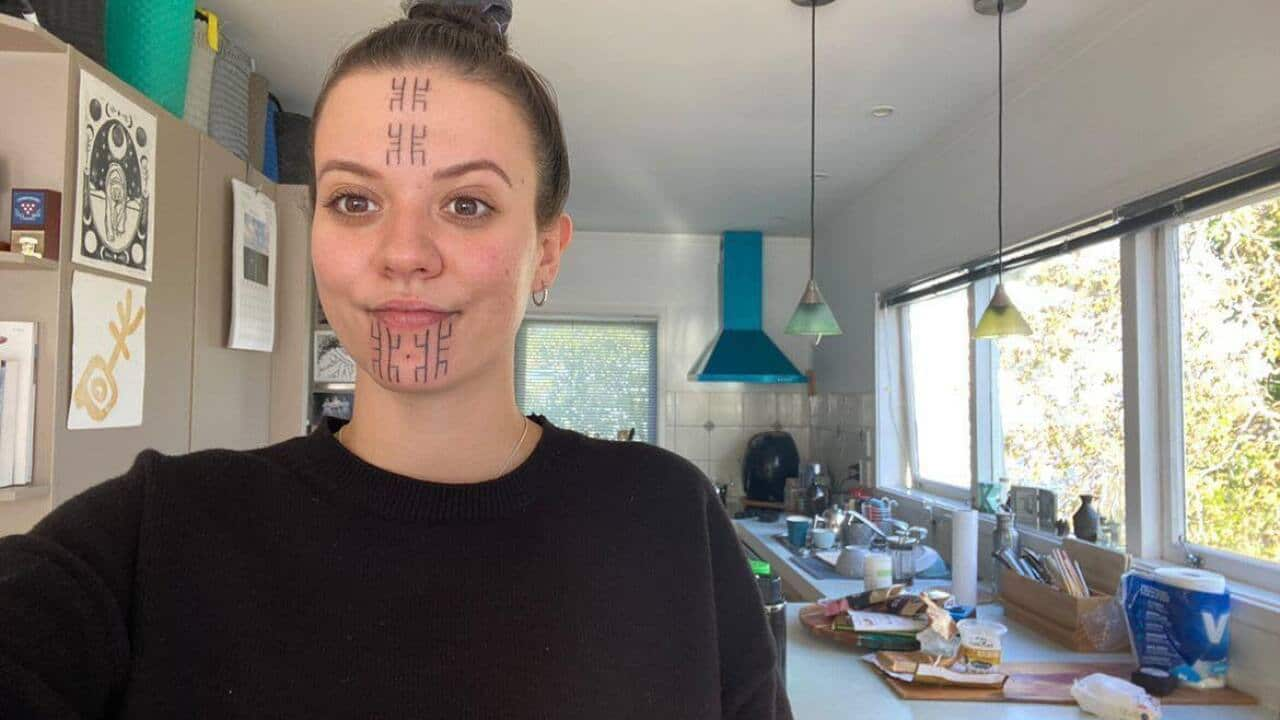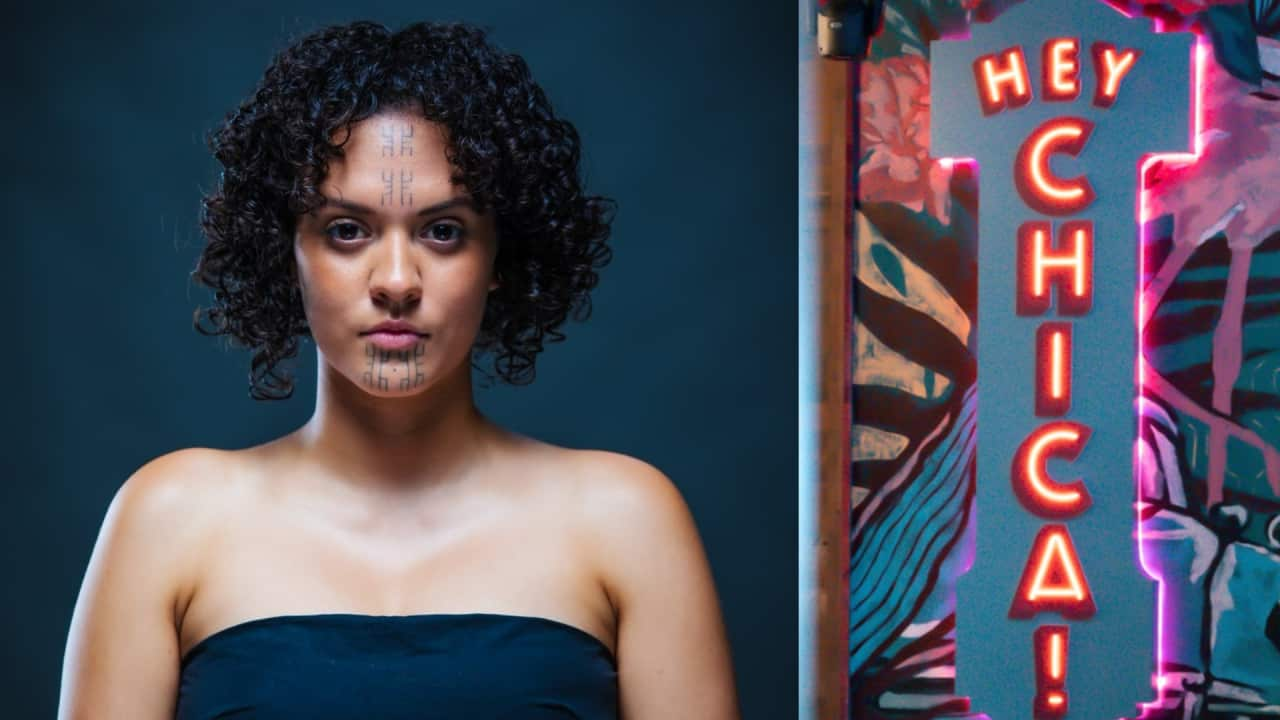

11 min read
This article is more than 1 year old
Feature
The story of my face
Moale James’ face was broadcast across Australia when she was refused entry to a Brisbane bar due to its tattoo policy, but there was a much more meaningful event that went before it; her journey to be connected to her ancestors by reva reva.
Published 8 July 2023 6:30am
By Moale James
Source: SBS News
Image: Moale James in 2023. (Nikita Pere Photography)
This article contains images of Indigenous people who have passed.
I look at my bare face in the mirror. Using my finger I trace a line from my forehead to the bridge of my nose, then down my chin and my neck.
My name is Moale Antonia Paia James. I am 23 years old, my parents' first successful IVF child and the eldest of 16 grandchildren.
Moale means ‘happy celebration’ in Motu, the language of the Indigenous Motu people of Papua New Guinea. My middle names come from my grandmothers; my nana (my father’s stepmother), Antonia, a Dutch migrant to Australia; and my Bubu, Paia, a Papua New Guinean migrant to Australia.
I am an Australian-Motu kekeni (woman).

Moale at home in Brisbane in 2022 before her facial marks. Credit: Moale James
But I have no marks on my face, yet.
Now I feel it is time, and I hope to have them for my upcoming university graduation.
All my markings have been done in the traditional way back home in Papua New Guinea using both the tapping and stick-and-poke techniques and under consultation with my community and matriarchal Elders.

A collection of reva reva marks drawn by anthropologists and published in works between 1894 and 1974. Credit: Various sources. Compiled by Moale James
I can only hope they agree it’s time for my facial markings as it’s up to them to decide what the most appropriate mark for me to bear is at this time of my life.
I’m excited, but impatient. The reason? I am three generations late.

Moale’s great-grandmothers Palu Bore, left, and Vabu-Dou in Gaba Gaba with Moale’s mother Ranu as a child. Source: Supplied by Danyal Syed / Moale James
It meant my grandmother and mother initially missed out.
The story I am about to share is both Lau Gatagu (my great-grandmother) Palu Bore’s story and Lau Gatagu (my great-grandmother) Vabu-Dou’s story.
It is also Lau Tubugu (my grandmother) Paia’s story and Lau Sinagu (my mother) Ranu’s story.
And it is my story, and will become my children’s.
My great-grandmothers were sisters; daughters of the village chief, Raga Maru. Our legends say the chief instructed his daughters to permanently mark their skin with their family's history and ways of living so that our story would forever be known.
They were marked with reva reva from head to toe and had no need for clothes apart from a grass skirt.

Motu/Koitapu girls on Ela Beach for a Hiri Moale Festival. Credit: Sailing For Survival by Mary R. Mennis
The Hiri Moale Festival, where the Hiri queen is appointed, still takes place every year. Though beauty is one aspect of it, the ‘winner’ must have the capability and elegance to carry out their duties, and their markings and body ornaments tell the story of that woman’s village.
The men’s reva reva practice was lost before it could be documented.
My great-grandmothers “were born during what they [missionaries] referred to as ‘the time of darkness’, where there was no Christian influence”, my mother tells me. But things would soon change.
My mother shares the story of her grandmother seeing the local Christian minister coming towards her and lifting her skirt to cover her breasts so as not to offend him.

The location of Moale’s village Gaba Gaba in Papua New Guinea. Credit: Google Maps
The shaming of women’s reva reva meant they had to practice in secret before it eventually stopped.
There is one story about a missionary walking into a ceremony, taking the tools out of the hands of the artist and throwing them into the ocean. The woman, who was only young at the time, is remembered to have walked around the village with a half-completed mark on her arm.
My grandmother was born during what missionaries called the ‘time of light’, when Christian values and ways of living had been embedded into everyday practice. She was adopted by my great-grandmother Vabu-Dou.
The reva reva practices were paused during her childhood, so she has no traditional marks, except for one on her arm which she received with her daughters in a Western tattoo parlour in Adelaide.

Moale’s Bubu (Grandmother) Paia has no facial markings. Credit: Moale James
“I feel so sorry that I did not get my tattoo like my mother's but I am so proud of my daughters for wearing them today,” she tells me.
She married an Australian man in 1970, five years before Papua New Guinea gained independence from Australia. They built our family’s village house in Gaba Gaba — which we still visit as often as we can — before settling in Australia.

Moale’s family tree, drawn by her Bubu (grandmother) Paia and grandfather. Source: Supplied by Danyal Syed / Moale James
When she received the call to say her mother was dying, she got on the next plane home. In her final days, my great-grandmother gifted her a piece of paper on which she had drawn her marks and said, “These are for Ranu and for all the eldest daughters”.
This paper now sits in a scrapbook and is the first point of reference whenever someone in the family is marked.

Moale’s Sinagu (mother) Ranu got her facial markings in 2001, years after the practice had been silenced back home. Credit: Moale James
Her marks can now only be referenced by the few photos we have of her.
I land in Aotearoa with my mother and we are met by our family’s marker Julia Mage'au Gray, or Auntie Julia as I refer to her as a respected Elder in the community.
She is a Papuan Australian skin-marking artist known for her work in revitalising marking traditions from Papuan communities, and directed a three-part documentary, , (which effectively means ‘talking about tapping’).
Marking skin is intimate and intense. People bring their own energies and stories which Auntie Julia says she carries forever from the moment she breaks their skin with the needle.

Moale prepares for her marks with Julia Mage'au Gray, as her mother watches on. Credit: Aisa Pokarop
I had also asked loved ones to share songs with me to play during the markings to acknowledge them, both traditional Motuan peroveta and contemporary songs.
I step through the doorway with purpose. We are carrying the stories of our ancestors, and in doing so, all in the room must give off the same energy.
I step through the doorway with purpose. We are carrying the stories of our ancestors ...
Almost immediately, a wave of nausea overcomes me, but this is not nerves. I have entered a space where both the living and those who have passed can communicate, including my two great-grandmothers.
Auntie Julia hands me a cup of hot ginger tea, known to keep spirits within their realms and protect your spirit from being lost.
Auntie Aisa, Julia’s cousin, acts as the skin-stretcher, and my mother draws the marks on my forehead and chin with a marker pen.
Auntie Julia then starts her work with the needle and tattoo ink.
(Video above: Moale receives her marks. Credit: Moale James and Julia Mage'au Gray.)
My marks are replicas of what was on my great-grandmother Palu’s face. The pattern is thought to represent the backbone of a fish.
My Bubu Paia (grandmother) says marking the forehead specifically is a sign of great respect for your Elders as it’s essentially a big sign on your forehead saying, ‘I love you’.
In the room, Auntie Aisa cries for us. “I’m the only one crying today!” she says.
We laugh in response. It’s an emotional space, mixed with sadness knowing what we have lost, but joy for what we have learned and where we are today.

Moale receives her marks. Credit: Ranu James
We take breaks to eat chocolate, tell stories, and I keep my family updated via Facebook.
I then look into the mirror and we all go silent.

Source: Supplied by Danyal Syed / Moale James
“How do you feel?”, Auntie Julia asks me.
“Like they have been here forever, but now all of you can see them,” I say.
She responds: “It’s almost like our practice took a breath for a moment; skipping a generation before beginning again”.
Time for reflection
Later, we are invited to meet with Ngāti Whātua man Graham Tipene, a local artist who practises Māori tattooing known as Tā moko. It is important to meet with him and his family as we are marking on Ōrākei, a Country that is not our own.
We visit a large black stone building at Mission Bay where a sign reads: “This was the site of an Anglican Mission, built in 1858-59, to provide Melanesian boys with a Christian education and enable the spread of Christianity through Melanesia”.
Underneath is a map showing where the group travelled to. My village, Gaba Gaba, is highlighted.
“So this is where it began?” I say.
The four of us — my mother, Auntie Julia, Auntie Aisa, and I — stand in silence. Decades on, we the descendants stand proud, our bodies now being marked again with the stories of our people that others hoped to erase.
“It didn’t work,” I say to myself, my face still bearing droplets of blood and ink that have spilled out from my skin.

Moale at her university graduation with her parents and partner. Source: Supplied by Danyal Syed / Moale James
I would later return to Papua New Guinea, after the pandemic had eased, and visit her mother’s grave.
Though I never met my great-grandmothers, I hope they would recognise me today as one of their own. My face is a daily reminder for me that I only exist because of them and I have an ongoing responsibility to my community. With my other marks, I didn’t feel the responsibility that I do now.
I have no doubt their spirit exists within me and I am now forever connected to these women by blood, song, spirit and reva reva.
A month after receiving her marks, Moale James was refused entry to a bar in Brisbane due to its policy on facial tattoos. After making a complaint to the Australian Human Rights Commission, she initiated a mediation process with the bar company and in June 2023 it changed its policy across all its venues.
This article is adapted from a 2022 Queensland University of Technology story by Moale James and Stephanie Wong.


